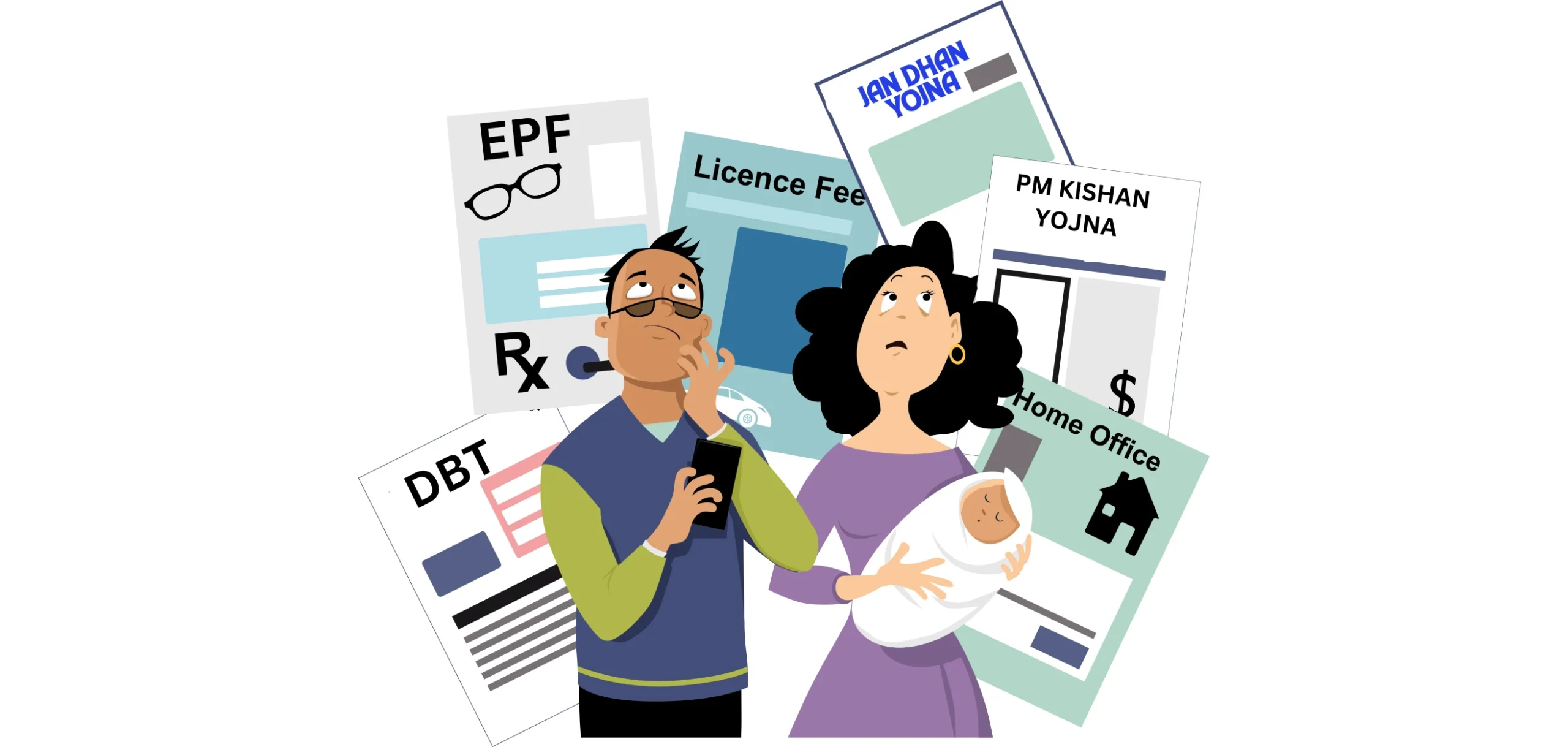What Is Financial Assistance?
With over 9 years of experience in banking and customer service, we’ve met many people who needed financial help for education, housing, saving for retirement, or starting a small business. Most of the time, help was available through government schemes, but they didn’t know how to apply or where to begin.
That’s why we made this simple guide. It will show you step-by-step how to apply for popular schemes like EPF, PMAY, PPF, PMJDY, Awas Yojanas, and more. Whether you need a subsidy, a low-interest loan, or direct money support, this guide will help you understand and apply easily in 2025.

Topic Highlights
1. Employees’ Provident Fund (EPF): Secure Your Retirement Savings
The Employee Provident Fund is the foundation of India’s retirement savings scheme for all employees, designed to ensure financial security in their golden years after retirement. This fund is managed by the Employees Provident Fund Organization (EPFO).
Its main objective is to teach the habit of saving among the employees and also to provide them financial security after retirement.
Notably, EPF allows employees to make multiple payments in multiple ways, such as paying for the purchase of a house or paying in advance for medical treatment or making payments in case of unemployment, making it a multipurpose financial tool in today’s times. That is why EPF is the popular Financial Assistance Schemes for the private and governement employees.
- Benefits: Employees contribute 12% of their salary, employers match this contribution. The accumulated amount earns interest, helping employees build a substantial retirement fund. Also, they can claim advance as previously mentioned.
- Official Source: EPFO India
2. Employees’ Pension Scheme (EPS): Lifetime Pension Benefits After Service
The Employees’ Pension Scheme (EPS) is a retirement benefit scheme for employees in India, providing monthly pensions after retirement or in cases of disability or death. Main eligibility for EPS requires a minimum of 10 years of service, and members must contribute through the Employees’ Provident Fund (EPF). To apply, eligible employees are automatically enrolled when they join the EPF.
- Eligibility: Employees who are part of the EPF scheme.
- Benefits: A monthly pension is provided based on the number of years worked and the amount contributed.
- How to Apply: Employees are automatically enrolled when they join the EPF scheme.
- Official Source: EPFO India
3. Public Provident Fund (PPF): Long-Term Savings with High Interest and Tax Benefits
The PPF Scheme is a government-backed savings plan designed to help individuals build long-term savings with attractive interest rates and tax benefits.
- Eligibility: Any Indian citizen can open a PPF account and a PPF accounts can also be opened for minors by their guardians.
- Benefits:
- Attractive Interest Rate: PPF benefits 2024 everyone Earning interest at 7.9% per annum, compounded yearly.
- Tax Benefits: PPF Contributions up to ₹1.5 lakh are eligible for tax deductions under Section 80C of the Income Tax Act.
- Loan Facility: Best thing of this scheme is After 1 year of account opening, you can take a loan against the PPF balance.
- Partial Withdrawals: After 5 years, you can withdraw up to 50% of the PPF account balance.
- You can open a PPF account by submitting Form-1 at any designated post office, nationalized bank, or online (if your bank provides the facility).
- How to Apply: You can open a PPF account by submitting Form-1 at any designated post office, nationalized bank, or online (if your bank provides the PPF facility).
- Official Source: India Post – PPF
4. Pradhan Mantri Jan Dhan Yojana (PMJDY): Accessible Banking for Every Citizen
Like our other important schemes, Jan Dhan Yojana is also one of the most revolutionary Financial Assistance Schemes made by the Modi government in 2014.
Its aim is to ensure access to basic banking services to every Indian citizen and promote basic banking. This initiative launched in 2014 provides a platform for individuals to save money and receive government benefits in their account. This scheme emphasizes banking as a powerful tool for economic empowerment and promoting financial literacy.
- Eligibility: Any Indian citizen can open an account under this scheme.
- Benefits: It offers a zero-balance savings account, with a debit card, and an accidental insurance coverage of ₹2 lakh. This program provides free money help by facilitating easier access to banking services.
- How to Apply: You can apply at any public or private bank branch or through the bank’s online platform.
5. Awas Yojanas: Making Affordable Housing a Reality for Every Indian
In India, both the central and state governments have created several schemes to help poor people get permanent pucca house, whether in rural or urban. These programs aim to provide financial help, subsidies, and support to build homes for those who don’t have one. The goal is to make it easier for low-income families to own a strong, pucca house. Some of these schemes are managed by both the central and state governments collaboratively, while others are specific to certain states.
6. Complete Guide to Scholarships in India: Government and Private
Education can change your life, but many students in India face money problems that make it hard to study further. To help with this, the central and state governments, along with private companies, NGOs, and CSR programs, offer many scholarships. These can be based on good marks or financial need and support students from school to college and even professional courses.
In this guide, you’ll find simple information about all the important scholarships, how to apply, and how to make the most of these opportunities.
Conclusion
Whether you’re a farmer, employee, or business owner, the government’s financial assistance schemes are designed to support you in various stages of life. Explore these schemes today, and please make sure you’re taking full advantage of the benefits our government offers.
FAQs for Financial Assistance Schemes
1. What is the Employees’ Provident Fund (EPF) and how does it benefit me?
Answer: The EPF is a retirement savings scheme designed to provide financial security for employees after retirement. Both employees and employers contribute 12% of the employee’s salary to the EPF, and the accumulated amount earns interest. EPF offers benefits like tax savings, early withdrawal for emergencies, and long-term financial security.
2. How do I apply for the Public Provident Fund (PPF)?
Answer: You can apply for a PPF account by submitting Form-1 at a designated post office or any nationalized bank. Many banks also allow opening a PPF account online if you hold an account with them. This long-term savings scheme offers attractive interest rates and tax benefits.
3. What is Direct Benefit Transfer (DBT), and how does it work?
Answer: DBT is a system through which the government directly transfers financial assistance to beneficiaries’ bank accounts, reducing delays and eliminating intermediaries. To receive DBT benefits, you must link your Aadhaar number with your bank account. This is the most popular Financial Assistance Schemes nowadays.
4. Who is eligible for the PM-Kisan Samman Nidhi Yojana, and what are its benefits?
Answer: Small and marginal farmers who own less than 2 hectares of cultivable land are eligible for the PM-Kisan Yojana. Under this scheme, farmers receive ₹6,000 annually, paid in three installments, directly into their bank accounts to support agricultural activities.
5. Can anyone open an account under the Pradhan Mantri Jan Dhan Yojana (PMJDY)?
Answer: Yes, any Indian citizen can open a Jan Dhan Yojana account. This scheme provides access to basic banking services with zero-balance accounts, a debit card, and benefits like accidental insurance coverage of ₹2 lakh. It is designed to promote financial inclusion for all citizens.
Looking for more details?
Visit our Scheme Saathi Home Page to explore more about government schemes and how they can benefit you. Stay informed and empowered!


